The first talk of the morning is from Kim Bjornquist on The Power of Language in the Clickbait Age. According to the conference agenda, the talk is going to cover the following:
Why do content marketing campaigns fail? According to a recent study, a combination of too little time, and ‘bad’ writing might be to blame. But to what extent are these two factors related? In this session, Kim will explore these factors, and others, and demonstrate how the words we choose don’t reflect reality – they create it.
Kim Bjornquist is a freelance creative, who specialises in copywriting, idea development and consumer sociology at Kristiania University College in Oslo. Apparently Kim has also published 5 books, the latest being The Language of the Market” and is about language and social constructivism, how the words we choose actually shape our reality.
As a language nerd, I’m excited for this talk this morning – apparently, he’s also funny… so let’s dive in! Kim kicks off with the first of a fair few quotes:
Language is not a mirror, it is a hammer!
What does this mean? According to Kim, we are used to seeing language as something that describes reality, whereas actually, it creates reality. When we talk about ‘reality’, it’s always something we make up. Even if we think about scientific reality, we, as humans, made all that up. And in marketing specifically, we make money from making up that reality.
‘You may have chosen the wrong words’
Kim begins by talking about the creative process. He has been creative all his life, he claims. It is very important and very hard to be creative, which we are always reminded by the tabloids and the movies. All his life, Kim has worked with words, and recently he’s been fascinated with the change when we entered the digital age.
He got his first word processor in 1984, and since then the way we communicate has changed infinitely. For example, asks Kim, who calls up someone now for their birthday? About three people put their hand up, including my colleague James ‘Wahaca’ Watkins.
Kim says he wanted to explore this change in communication, so he wrote a book called, ‘The language of marketing’ (which is not available in English…yet. Insert plug in asking for any English publishers) He said the first thing you do when you write a book is you Google it – and nothing came up that was relevant.
So who can we blame for low quality content online?
Can we blame the newspapers?
Not really, says Kim. As content creators we have a responsibility.
He gives an example of some pretty crass marketing campaigns (see below) and says people like us, as marketers, we created this. These campaigns went through a whole host of sign offs and somehow they are still awful. Who approved this?

In the struggle to be seen have we neglected the importance of being understood?
Kim says that we should focus more on the value of being understood, whilst we are all scrabbling to be seen across the web.
The creative process
He talks about the creative process, and how it really looks.
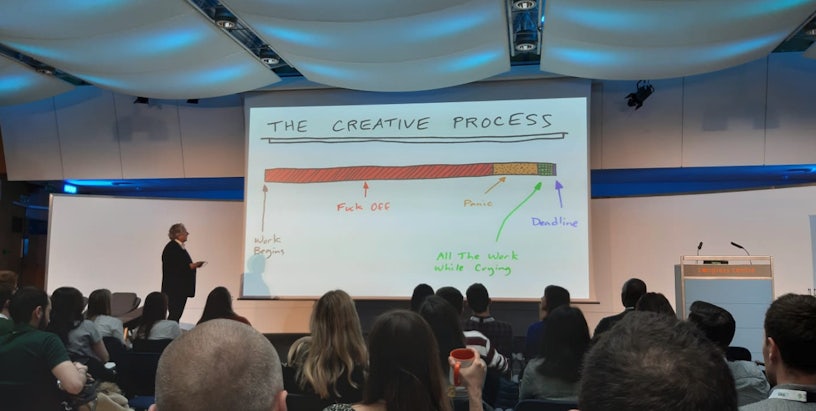
However, by doing the creative process in this way, we lose the ability to polish and refine. Having the luxury of time, and being able to put our creative ideas away for a couple of hours and looking at it later actually creates astonishing results. Kim says you end up thinking, “oh sh*t, did I do this?” and then you can go through and can improve it.
Kim mentions a study in which creative directors were asked: “what were the main issues for projects you are not happy with?” and apparently they said:
- Too little time
- Bad language
Time is the important thing, says Kim, it was mentioned more than anything else. But surely, in the current landscape, now we have all these algorithms and tools, surely we can save loads of time? Do we even need to send time on creativity now we have all these tools and intelligent algorithms?
Kim doesn’t think so. He gives us another quote.
We aren’t in the technology business, we are in the f*cking creativity business
George Lois, Cannes Lions, 2013.
Despite this, Kim says he’s lazy and when there is tech to make his life easier, he embraces it. However, using the tech alongside the creative brain is the best solution, says Kim.
Kim says he’s an old hippie, so we have a short break where he says we all have to hold hands and sing kumbaya together. Fortunately (I think) it’s a joke, and I don’t have to actually touch anyone. Back into the talk.
So what are we doing when we create content?
Learn the rules like a pro, so you can break them like an artist.”
Kim talks about a conference he was at in Germany recently where he was socialising with some computer game creatives. He was speaking to a game designer and he described himself as a ‘world builder’ – for computer games presumably.
This got Kim thinking, isn’t this what we all do? We build worlds for our clients. Deep.
Social constructionism
This brings us onto social constructionism, the idea that words create reality, they don’t reflect it.
He begins to tell us about a German philosopher who was interested in the construction of language, who used a metaphor for words, whereby he said that words are like pieces on a chessboard – there are strict rules on how you move them but they have no meaning without the chessboard.
This concept covers how actually words are simply what we say they are. He uses a couple of examples of social context: soul music vs soul in spirituality. We have learnt these things from a young age and its all about context. There is a thin slice between content and users.
Who are users these users of which we speak?
- Target group
- Audience
- Consumers
- ‘They’
Whatever we want to call them, the fact is that ‘they’ don’t look at themselves as any of these.
Have you seen Life of Brian?
An excellent piece of art, Kim claims. I am inclined to agree. “He’s not the messiah, he’s a very naughty boy,” whispers James next to me. Anyway, Kim is referring to this particular scene:
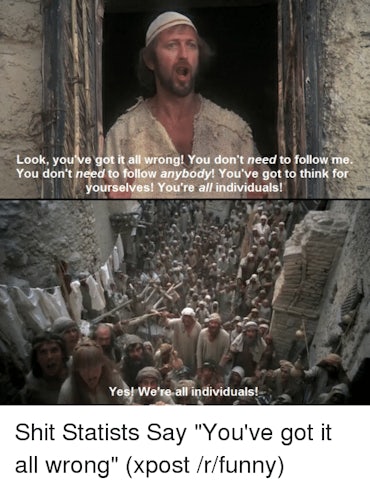
As consumers, we want to feel unique. We we need to talk to ‘them’ like people – not like they are just walking wallets. He uses the example of Nike. They’re wonderfully imprecise “just do it” to some more in depth advertising campaigns, such as the controversial Colin Kaepernick advert.
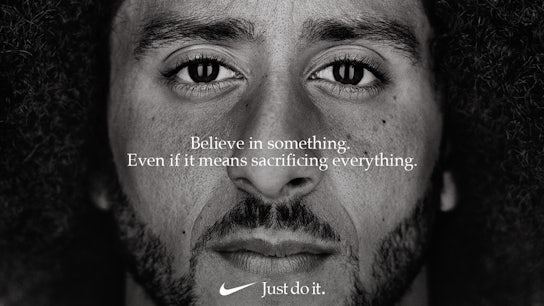
They know that this advert would ruffle some features, and people actually started burning Nike shoes. Nike responded by showing them how to burn the shoes safely. According to Kim, the marketing campaign increased their stock by 6bn US dollars.
Tap into the emotions of your audience
Kim says that we should never promise too much; if you promise everything, you really promise nothing. The better you know your target group then the more careful you have to be with your language.
Everyone knows the OG four ‘P’s in marketing, right?
Well, we should look at the new four ‘P’s in the digital age.
- Promise (but don’t lie)
- Picture (get them to see and believe the benefits)
- Proof (as much as you have)
- Push (CTA)
But you should convince them first before you hit them with the CTA.
Kim says that advertising is tying feelings to a product and transferring those feelings to those you want to reach. He shows this “feelings” graph in marketing, including a whole host of emotions across the board which can be used in marketing:
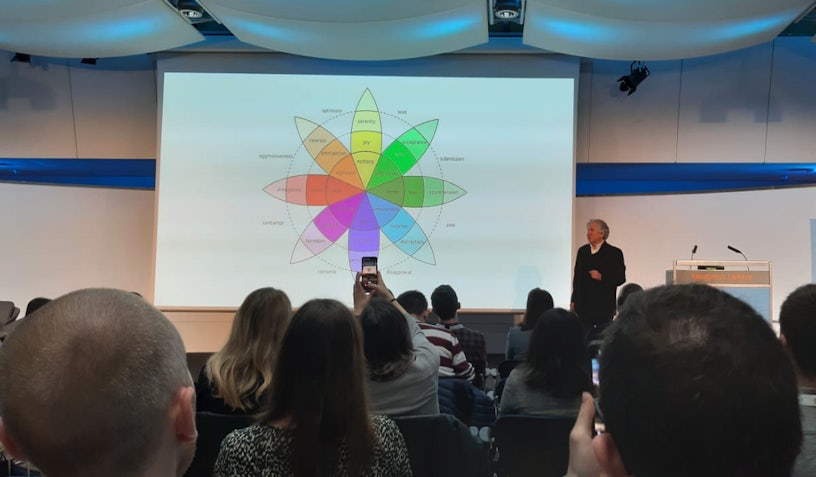
And then he showed the same thing, but with a heat map which shows the amount of net traffic per feeling:
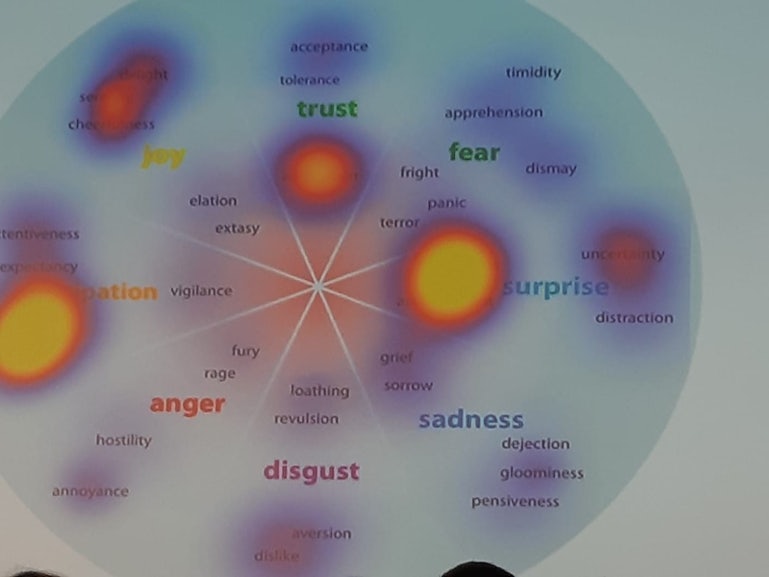
Kim talks about using an ESP rather than a USP, tapping into an ’emotional selling point’. What’s the best tool we have for that? Language.
Kim says that James Webb-Young claims that words are symbols. If we see words like this, then we can understand how important it is to not screw around with them. For example, if we look at some bad examples of graphic design, we can understand why its important to not screw around with symbols.
He gives some examples of this, putting the ‘graphic’ in graphic design…
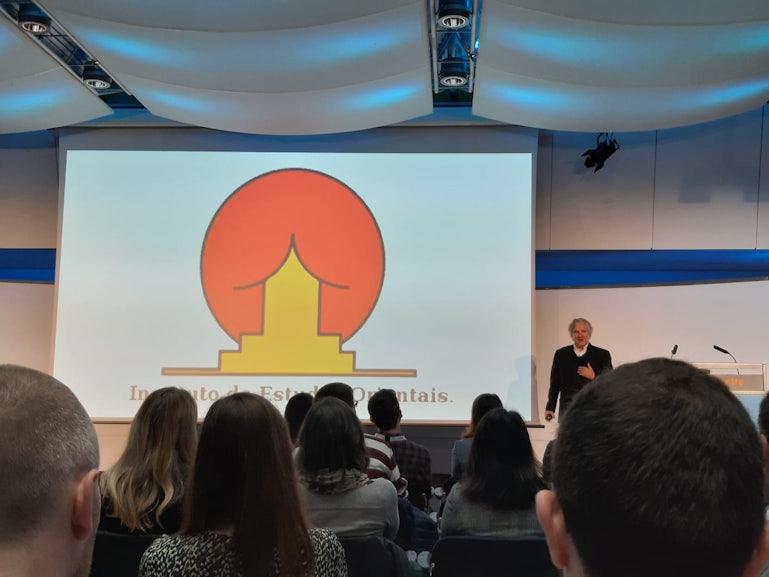
In this way, when we’re putting together a piece of content, we need to think about ROIT (ROI of time).
What does the consumer get from the benefits of reading your piece? If you cant answer that quickly, you need to build it again. We should do the following:
- Show – don’t tell.
- Teach – don’t sell.
- …or show, teach and then sell.
For example, don’t tell me about your wonderful new bed. Tell me about the wonderful feeling about waking up after a good nights sleep. “It’s about feelings”, says Kim.
Additionally, we are always looking for something ‘unique’. Just because it’s unique, doesn’t mean it’s useful. It needs to work, says Kim. If words are your business. Play with them.
He uses the example of Norwegian Air advert after Bradgelina broke up:
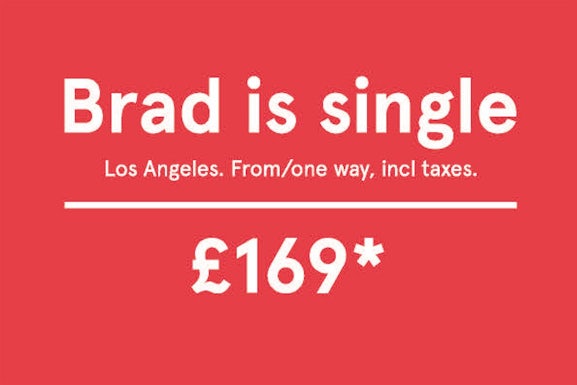
It says: we know who you are, we know that you know this, we know that you fancy for Brad Pitt.
He mentions another airline who did a rip off version of this after the success of this campaign. But is it okay to plagiarise in this context? As he concisely puts it.
“It’s not where you take it from, it’s where you take it to.”
When we are tired, we say what our competitors say. Try mixing around with language to make it more compelling and tap into the feelings and emotions, he says. For example:
- Steakhouse Don’t say: “Our steaks are great” Do say: “Yesterday one of our guests refused the heimlich maneuver”
- Blood donation campaign Don’t say: “donate blood, save a life” Do say: we want your blood, not your excuses.
- Anti-smoking campaign Don’t say: smoking increases your chances of cancer Do say: Want to know more about cancer? Keep smoking.
- Hunger catastrophe in Sudan Don’t say: Save the children need more money Do say: Beatrice didn’t give money to Sudan, there was a summer sale at Harrods
This works because the real issue is that people don’t give money, and thats what you need to tap into.
Liberate your inner ‘god rabbit’
The god rabbit is a concept that his son came up with in a drawing, and Kim uses it as an example of the kind of infinite creativity that children have. One of the hardest things is getting back into the effortless creativity you have as a child. Brilliant ideas are never logical – until afterwards. He says that logic and reason have their place in the creative process, but it’s right at the end. Try and remove those confines. To do that, he gives us a short exercise.
Short exercise
Kim wants to do a short exercise with us at the end, and it’s all about changing our perspective. 1. Relax. Close you eyes. 2. Think of your favourite street in your fave city. Walk down it and describe it in your mind. 3. Do the same thing again but without describing what we’re seeing. Just all your other senses. Not what you see. 4. Did it change your perspective? Do this with your writing, try to change your perspective. The chances of being original increase. It takes just one minute to change the process. That’s the end from Kim, but before he goes, he leaves us with one thought: “We don’t see things as they are, we see things as we are.”
Questions?
Q: What’s your favourite creative process?
A: “Post-its. I am the f*cking king of post-its. Write everything down. Put them up on a board, then group them all together into themes. But ‘it’s like sex, it’s better if theres someone else there as well.. Brainstorming is my least favourite, people invest too much of their own personality into it. Post-its is more anonymous.”



